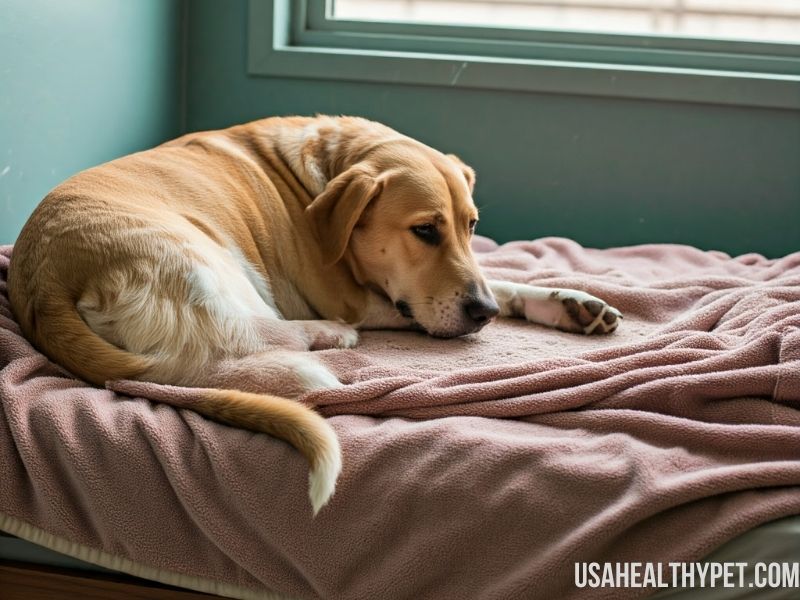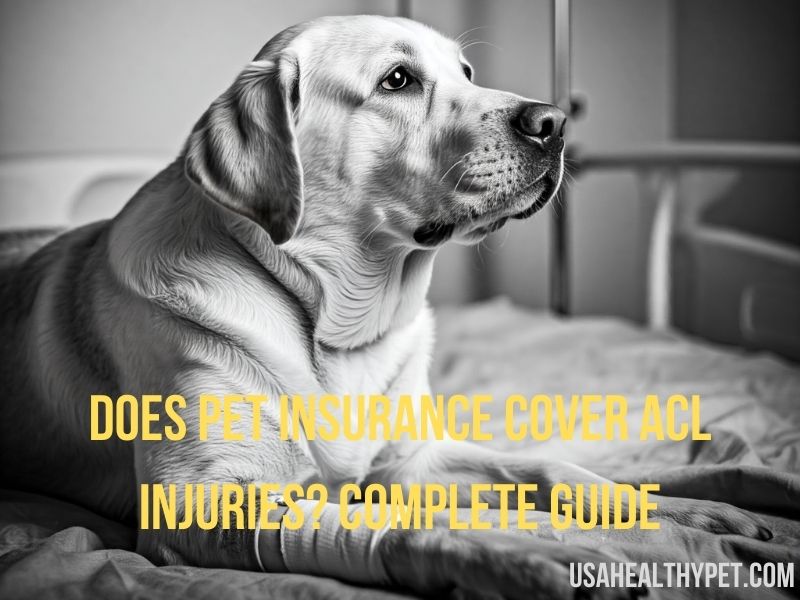ACL injuries aren’t just a human problem; pets, especially dogs, are quite prone to them too. The “ACL” (Anterior Cruciate Ligament) is a major ligament in the knee that helps stabilize the joint.
In pets, it’s often referred to as the cranial cruciate ligament (CCL), but for simplicity, we’ll stick with ACL. If your pet suffers from an ACL injury, you may notice them limping, favoring one leg, or even refusing to walk.
ACL injuries in pets can happen suddenly, usually from an awkward jump or a sudden twist while running. They can also develop over time due to wear and tear, particularly in older or larger dogs.
This can be a painful experience for your pet, and surgery is often recommended for effective recovery.
Does Pet Insurance Cover ACL? Key Points
- ACL injuries in pets are common, especially among active and larger dogs. They impact the knee, leading to pain and restricted mobility, often requiring surgery for effective recovery.
- ACL surgery for pets can be costly, with prices ranging from $800 to $5,000. The price varies based on the type of surgery and additional costs like post-surgery care.
- Many pet insurance policies cover ACL surgery but may have restrictions such as waiting periods, breed-specific exclusions, and no coverage for pre-existing conditions.
- Enrolling your pet in insurance early can increase the chances of ACL coverage, as waiting periods and lack of prior knee issues make claims easier.
- Consider alternatives if insurance won’t cover ACL surgery, such as payment plans, pet savings funds, or financing through services like Care Credit.
What is ACL Surgery for Pets?
ACL surgery is a procedure to repair the torn ligament in your pet’s knee and restore its stability. Given how crucial this ligament is for movement, surgery is often the best option to help your pet get back to their playful self.
Without it, your pet may continue to experience pain, reduced mobility, and even arthritis in the affected knee.
This type of surgery requires expertise and advanced techniques, making it one of the more complex orthopedic surgeries for pets.
Veterinarians usually suggest surgery based on the severity of the tear, age, weight, and overall health of the pet.

Types of ACL Surgeries Available for Pets
When it comes to ACL surgery for pets, there are three main types veterinarians may consider:
- Lateral Suture Technique (Extracapsular Repair): This method involves placing a strong suture outside the knee joint to stabilize it. It’s often chosen for smaller dogs and pets who aren’t too active.
- Tibial Plateau Leveling Osteotomy (TPLO): This approach involves adjusting the angle of the tibia bone to reduce the stress on the ACL. It’s a more involved surgery, generally recommended for larger, more active dogs.
- Tibial Tuberosity Advancement (TTA): Similar to TPLO, this procedure alters the bone structure in a way that makes the ACL unnecessary for stability. It’s also a common choice for bigger dogs.
The type of surgery recommended depends on your pet’s size, age, and activity level.
Each of these surgeries has a recovery period and specific post-operative care requirements, but they all aim to get your pet back on all four paws as quickly as possible.
The Costs Involved in ACL Surgery for Pets
ACL surgery for pets can be pricey, and costs vary depending on the type of surgery. Generally, you can expect the following price ranges:
- Lateral Suture Technique: $800 to $1,500
- TPLO Surgery: $2,000 to $5,000
- TTA Surgery: $2,000 to $4,500
Apart from the surgery itself, you might have additional expenses like diagnostics, pre-surgery tests, post-surgery checkups, and rehabilitation therapies.
With all these combined, ACL surgery can quickly reach thousands of dollars, making pet insurance coverage a topic of interest for many pet owners.
Does Pet Insurance Typically Cover ACL Surgery?
Now, let’s address the main question: does pet insurance cover ACL surgery? In many cases, yes, pet insurance does cover ACL surgery—but with a few caveats.
Most pet insurance plans categorize ACL injuries under accident or illness coverage, provided that the injury happened after you enrolled in the plan.
However, not all policies include ACL surgery as standard. Some insurers may require you to add on specific orthopedic or knee coverage.
It’s crucial to read the fine print, as some insurers exclude ACL injuries for specific breeds, and nearly all insurers will not cover ACL issues as a pre-existing condition.
Laura Bennett, an insurance analyst, advises pet owners to read policy details carefully, as “many policies exclude pre-existing conditions and may require specific exams or documentation to ensure ACL injuries are covered.”
Factors That Affect ACL Surgery Coverage
Several factors influence whether your pet’s ACL surgery will be covered by insurance:
- Waiting Periods: Many policies have a waiting period, especially for knee injuries, to prevent claims for pre-existing conditions.
- Pre-existing Conditions: If your pet has had knee problems before enrolling, ACL surgery won’t be covered.
- Breed Restrictions: Certain breeds are more prone to ACL injuries, and some insurers may limit coverage based on this.
- Policy Limits: Check your policy’s limits on surgical procedures or total annual coverage, as these can impact whether you receive full reimbursement.
Understanding these factors can help you make an informed decision about your pet’s insurance.

Waiting Periods: How They Affect ACL Coverage
Waiting periods are a common requirement in pet insurance policies, especially for orthopedic issues like ACL injuries. This is a set period after your policy start date during which coverage for certain conditions won’t apply.
Waiting periods for ACL injuries can range from 14 days to 6 months, depending on the insurer.
For pet owners looking to protect their pets against potential ACL injuries, it’s smart to enroll in insurance early and get through the waiting period well before any issues arise.
This way, you’re less likely to face a situation where your pet needs surgery but isn’t yet eligible for coverage.
How Pre-existing Conditions Impact Coverage
Pet insurance typically won’t cover pre-existing conditions, which includes any ACL issues that occurred before your pet was insured.
For example, if your dog had a limp or even a suspected knee issue prior to signing up, any subsequent ACL-related claims might be denied.
Some insurers offer limited coverage for pre-existing conditions if there hasn’t been a recurrence for a certain period (usually 12-18 months).
Still, if ACL coverage is your primary concern, it’s best to get insurance before any signs of knee trouble appear.
Steps to Ensure ACL Coverage for Your Pet
To make sure your pet’s ACL surgery is covered, take these proactive steps:
- Enroll Early: The sooner your pet is covered, the less likely you’ll face coverage issues if an ACL injury occurs.
- Understand the Policy Terms: Look for clauses regarding knee or ligament injuries, waiting periods, and breed-specific exclusions.
- Get Routine Health Check-ups: Routine vet visits can help catch any knee issues early and might provide documentation that can help with future claims.
- Ask About Orthopedic Exams: Some insurers require an orthopedic exam at enrollment to verify there are no pre-existing issues with your pet’s knees.
By following these steps, you can maximize your chances of having your pet’s ACL surgery covered if it’s ever needed.
Pet Insurance Plans and ACL Coverage: A Comparison
Pet insurance providers vary widely in what they cover for ACL surgery, so it’s useful to compare a few top plans:
- Embrace Pet Insurance: Offers coverage for ACL surgery after a waiting period and includes breed-specific orthopedic issues.
- Healthy Paws: Covers ACL surgery as long as there are no pre-existing knee issues.
- Nationwide Pet Insurance: Provides optional add-ons for orthopedic coverage, which can include ACL surgery.
Consider your pet’s breed, age, and health status when comparing plans to ensure you get the best coverage for ACL issues.
Alternative Financing Options if Coverage Isn’t Available
If pet insurance won’t cover your pet’s ACL surgery, there are other options you might explore:
- Care Credit: A health credit card that offers interest-free periods for medical expenses, including pet surgeries.
- Payment Plans with Vets: Some veterinary clinics provide financing options or payment plans.
- Pet-specific Savings Accounts: Setting aside funds specifically for pet health expenses can help cover unexpected costs.
Jane Smith, a pet financial planner, suggests creating a “pet emergency fund” for unexpected surgeries or treatments not covered by insurance. This way, even if insurance has limitations, you’re prepared for the unexpected and won’t need to make difficult decisions based on cost alone.
Is ACL Surgery Worth It for Your Pet?
ACL surgery is a significant investment, but it can dramatically improve your pet’s quality of life. Without treatment, pets may continue to experience pain and mobility issues that affect their daily life.
However, if surgery isn’t feasible due to cost or other factors, options like physical therapy, weight management, and pain management can help.

How to Choose the Right Pet Insurance for ACL Coverage
Choosing the right insurance requires a bit of research. Here’s what to look for:
- Review Knee Coverage Terms: Make sure ACL injuries are explicitly included.
- Check the Waiting Period: A shorter waiting period is preferable.
- Compare Deductibles and Reimbursement Rates: Ensure that your policy fits your budget and will provide enough coverage.
Tips for Filing a Successful ACL Surgery Claim
When filing a claim for ACL surgery, it’s essential to provide thorough documentation:
- Submit Medical Records: Include all vet visits and any previous exams related to your pet’s knees.
- Follow Pre-Authorization Steps: Some insurers require pre-authorization for surgeries, so check with your provider.
- Submit Itemized Bills: Make sure all costs are itemized and related to the surgery.
Conclusion: Protecting Your Pet with the Right Coverage
ACL injuries can be tough on pets and expensive to treat, but with the right pet insurance plan, you can ease both the physical and financial strain.
By enrolling early, understanding your policy, and following the insurer’s guidelines, you can ensure your pet gets the care they need without breaking the bank.
ACL surgery might just be the support they need to return to their active, happy self, and pet insurance can be a crucial part of that journey.
FAQs
1. What does ACL surgery cost without insurance?
Without insurance, ACL surgery costs between $800 and $5,000, depending on the procedure.
2. Can pet insurance cover both knees if my pet has bilateral ACL injuries?
Some policies cover both knees if there’s no history of ACL issues, but each policy differs.
3. Are there any breeds more prone to ACL injuries?
Yes, breeds like Labradors, Rottweilers, and Bulldogs are more susceptible to ACL injuries.
4. What is the average waiting period for ACL coverage?
Waiting periods vary but are typically between 14 days and 6 months for ACL injuries.
5. Can I buy pet insurance after an ACL injury?
Yes, but the injury will likely be considered a pre-existing condition, and ACL coverage may be denied for that injury.

Pingback: Does Pet Insurance Cover Cremation Costs? Complete Guide
Pingback: Does Pet Insurance Cover IVDD? Essential Guide